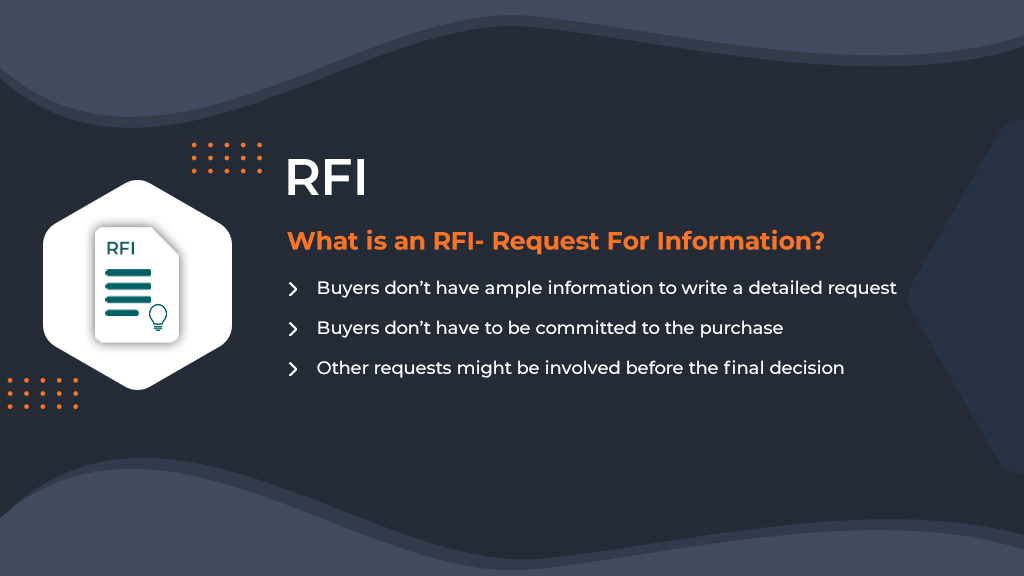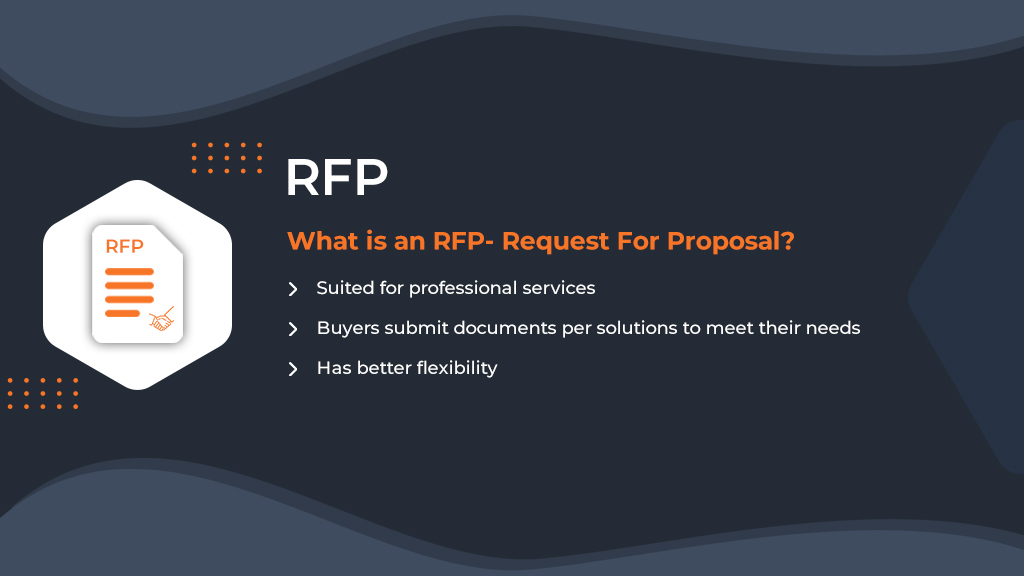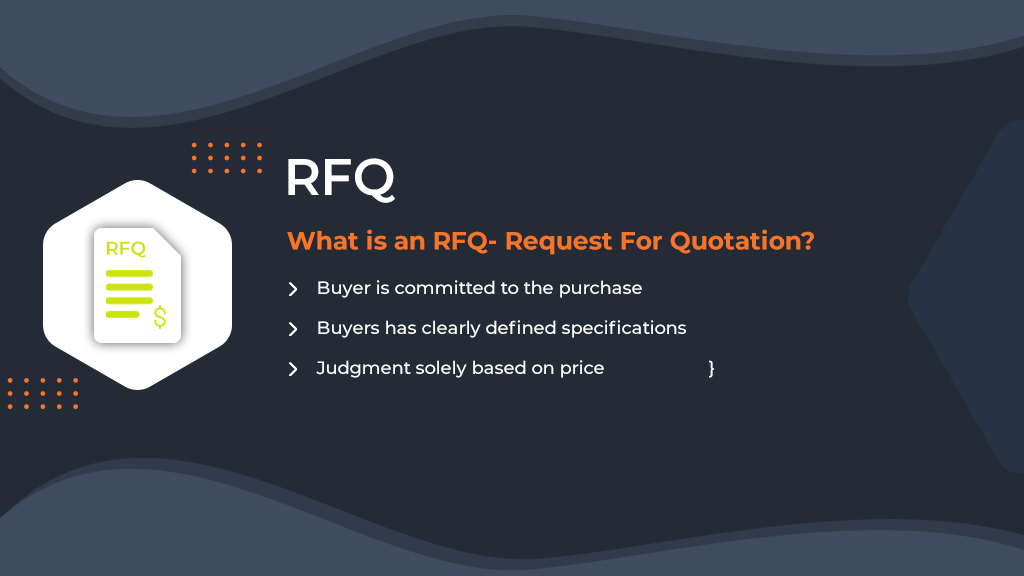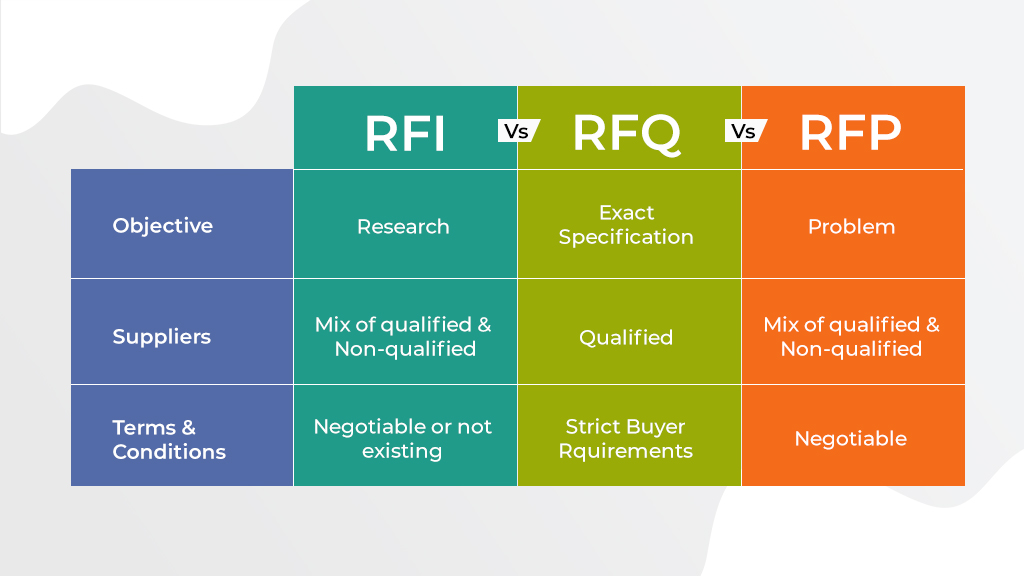RFI vs RFP vs RFQ – All You Need To Know
“RFQ,” “RFP,” and “RFI.” They’re often overused and misinterpreted, just like any other Three Letter Acronym in business. Today, we’ll describe these linked, yet unique business tools.
Efficient communication, exchange of knowledge, and structured information are essential to building successful projects and ensuring employee productivity.
Enormous projects fail due to poor communication and lack of market understanding. Many businesses face considerable losses due to a lack of contact between the company and the customers. Unable to understand the customer requirements, many businesses fail to build a solid brand identity in the market.
Due to a lack of formal contracts, many businesses get stuck in undesirable trade-offs leading to substantial financial losses. In addition, companies face issues in describing the organization’s goals, issuing contract terms, and outlining the bidding processes while making contracts with other organizations.
Thus to curb all these discrepancies, businesses need a sound knowledge of the customers to generate profits and gain a reputation amongst households. At the same time, organizations must adopt practices that help expand, grow, and increase the efficiency of their departments.
Despite being a small or a large-scale business owner, businesses must follow a quick procurement process to win a contract. Elements like the professional cover page, implementation plan, company overview, financial review, and pricing outline form the basis of a smooth contract plan.
RFI, RFP, and RFQ are project management processes primarily used for reducing business risk, increasing revenue, saving money, raising investment, and making the best possible business decisions. Organizations use them to gather information from vendors to help them take immediate steps to meet their growing business needs.
In addition, they are used for educating potential solutions that vendors can offer, detailing the costs, and evaluating the overall value a vendor can offer. They help simplify complex processes, including customer relationship management, supply chain management, and enterprise resource planning.
They also help communicate with the software vendors and define the products the company is interested in. Thus, RFI, RFP, and RFQ are undoubtedly wise investments that help raise the business’s profitability.
What is an RFI- Request For Information?

- Buyers don’t have ample information to write a detailed request
- Buyers don’t have to be committed to the purchase
- Other requests might be involved before the final decision
RFI is a set of questions circulated amongst vendors to question them about their products and services. For any project, RFI management is increasingly used to survey the market, obtain general information and find solutions for emerging problems.
Formulated casually, RFIs are widely used to educate and inform vendors so they can meet business needs. RFI management makes it easy to prepare and becomes an easy technique to fill in gaps during the research stage. Composed of open-ended questions, RFIs are widely used in the early stage of operations to define project requirements.
In the case of RFIs, the buyers are not necessarily committed to the purchases. RFIs help streamline the communication process and speed up the operations as all information is stored in standardized templates.
RFI management is occasionally used before an RFP as a tool for a buyer to survey the market and discover what solutions are available. After narrowing the project scope and defining specifications, the buyer may launch a supplementary RFP to solicit more precise proposals.
A corporation may be looking for a new type of consultant but doesn’t know their possibilities or how vendors structure their solutions. That’s an RFI usage.
What is an RFP- Request For Proposal

- Suited for professional services
- Buyers submit documents per solutions to meet their needs
- Has better flexibility
RFP is a detailed questionnaire used by buyers to obtain vital information from prospects and clients. The information collected is used to document and evaluate the performance of vendors.
RFP management helps bring solutions to customers’ requirements and business needs for streamlining projects. RFP is structured in a formal tone which helps provide a vivid comparison of vendor offers and capabilities.
The buying party (a firm, government body, or other entity) creates a written document or set of documents that includes specifications, critical milestones, cost expectations, and other requirements.
The buyer sends this RFP, or RFP “package,” to vendors to request proposals. Vendor proposals should include pricing, allotted resources, timelines, and whether they match RFP requirements.
You can structure RFPs by sharing background information about the problems faced by vendors. Compare the vendors on different scales, do in-depth research, and ask for examples and certifications. Avoid vague questions and ask for sellers’ expertise in case you are unsure.
What is an RFQ- Request For Quotation?

- Buyer is committed to the purchase
- Buyers has clearly defined specifications
- Judgment solely based on price
When we know what we want but need supplier information and/or pricing, we use a request for quotation (RFQ). It’s a price-and-payment request to specific solutions.
RFQs include a technical product or component specs. Often, schedules, cost targets, and other specifics are apparent.
RFQs are typically used for outsourcing specific tasks or subcontracted production. The buyer understands what they want and uses the RFQ to find the lowest price from a qualified supplier. RFQs are used more often in direct-material procurement when a buyer sources goods’ components or materials.
RFQ lists down the demands of the buyers. Formally structured, RFQs question the vendors with a detailed pricing proposal. It helps curb distractions and allows buyers to prioritize prices over other parameters.
To structure RFQs, provide a brief background picture and a list of requirements. Express your requirements in utmost detail, and format the list of products and features needed.
Provide all the details, including the number of goods or expected timeline for delivery of items. Companies should incorporate the mode of payment and pricing table inside RFQ. Thus, RFQ Software is suitable for professional platforms and allow buyers to submit transcripts based on solutions to meet their needs.
 RFI vs RFP
RFI vs RFP
RFIs are helpful for companies who are new to the marketplace. It is more or less a fact-finding document wherein vendors can explain how they license their products and their expected fees.
RFPs allow vendors to obtain the context to propose creative solutions and adopt sustainable habits to fulfill the business needs. Thus RFPs provide the flexibility to vendors to brainstorm extraordinary techniques to outline business goals and specify requirements needed for the tasks.
Request for information (RFI) management is utilized when the owner wants multiple contractors to submit prospective solutions, and a request for proposal (RFP) management is used to collect project quotations.
Multiple contractors may receive a fast RFI with basic questions, so don’t spend too much time preparing a decent response. They may decide to abandon the project.
If they have drawings, requirements, and qualifications/experience, they may release an RFP. If they need multiple quotations for a specific item, addressing the query is the best way.
RFIs give an insight into the broad business challenges faced by the vendors and the measures opted by them to curb the challenges. These documents provide a chance for the owner to receive several solutions to the problem and enable them to make suitable choices.
RFP lets vendors clearly define the standards and specifications required. In addition, in RFPs, companies may provide references, past projects, and resumes for the central staff.
RFI vs RFQ
RFI is quite useful for researching potential vendors. RFI management can be considered a suitable option for obtaining an overview of the market trends and demands. These are used to clarify and ask about the project’s design intent. RFIs help speed up internal communications by automating various elements integral to the overall process.
On the other hand, RFQs include target-based questions intended to know the exact number or type of services required. RFQs generally don’t foster creativity but help extract the specifications needed for the company.
These are useful when adding or augmenting an existing group of operations. RFQ management helps evaluate the vendor’s bid with the capability to fulfill requirements. To streamline procurement cycles, RFQs include other parameters, including descriptions, delivery needs, terms of the contract, and competencies.
RFP vs RFQ
The main difference between RFP and RFQ lies in their designed purpose. RFQs are used during the procurement process and can be sent independently.
RFPs are used to conduct a strategic proposal process.
This direct and formal document aims to compare different offers, simplify complicated processes, and evaluate factors apart from the price before making any decision. RFP management consists of terms and conditions bound to negotiate, thus helpful for large-scale problems with no quick solutions. RFPs help organize software requirements to achieve business goals and simplify complex processes.
On the other hand, RFQ management contains buyer and seller information, including the delivery requirements and the company description. RFQs generally focus on the relationship between cost and features. RFQ management helps determine the goods’ fair market value, thereby generating savings for the company.
In the case of projects with a specified scope of work, RFQs are used. Companies use RFQ management, where the judgment is based on price. Inquiries are used for making purchases that account for all government transactions.
Companies and research investigators must understand the difference between the three types to choose the proper format. Companies that are just starting must prefer RFIs. RFIs provide a rough budget without relying much on the vendors’ capabilities.
To obtain more information about qualifications and experience, head to no other than RFP management. Answering an RFQ is the best option for getting multiple quotes to compare prices and materials.
Beyond Intranet offers advanced visibility to various functions by creating templates, sending invites, and inviting vendors across the three types. Vendors can upload their proposals and email notifications and explore highly affordable pricing.
Thus, keeping in mind the particular purposes of the three types, choose the one which resonates with your goal.
Conclusion
RFI, RFP, and RFQ management can help firms save money, decrease trade-offs, and streamline procurement.
Please note that no ” request ” type” is better than others; it depends on the supplier. If you know what you want and merely need suppliers, RFQ is great. RFP management is valuable if you’re open to ideas but about to buy. RFI may be best if you’re still researching and want a supplier’s summary. The most critical component is knowing the difference between RFI and RFP so you can request the right one.
Your business may use one, two, or all three in the decision-making process based on pricing requirements, supplier knowledge, process scope, and project deadlines.






